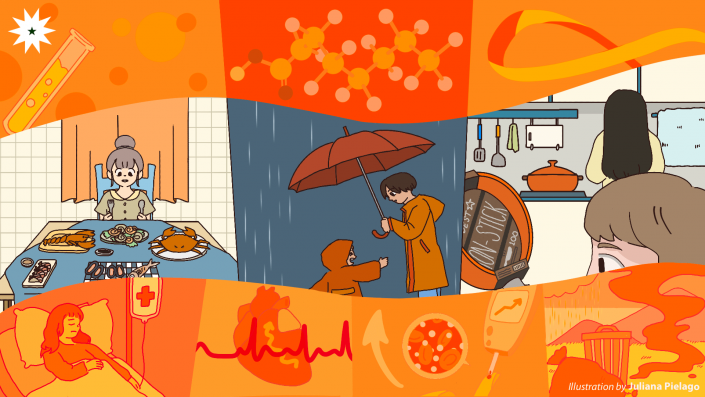As the country continues to brave through the rainy season, people rely on raincoats and umbrellas to shield themselves from the rain. To maintain the efficiency of these waterproof surfaces, manufacturers use perfluoroalkyl and polyfluoroalkyl substances (PFAS)—synthetic chemicals that consist of a long chain of linked carbon and fluorine atoms.

Dr. Michael Velarde, a professor from the University of the Philippines Diliman Institute of Biology, explains that PFAS are called “forever chemicals” due to their thermal and water resistance, which allows them to persist for years in the environment. However, these useful properties come at a cost: PFAS are toxic and can negatively affect one’s health. As higher concentrations of PFAS are detected in the ground, air, and water worldwide, more people are at risk of falling victim to them.
A man-made disaster
Velarde underscores that PFAS are usually found in waterproof and greaseproof products like water-resistant jackets—and even in microwavable popcorn.
After these products are used and consumed, they are often disposed of in landfills and oceans—increasing the risk of PFAS bioaccumulation in humans and sea creatures. As Velarde puts it, some of these chemicals will be “eaten by fishes—and then bigger fishes—so all of these [will] accumulate with time,” possibly ending up in natural bodies of water and the food that people eat.
The presence of PFAS in landfills and wastewaters can create toxic waste that will infiltrate the soil and other bodies of water like lakes and rivers. Without proper interventions, this can lead to the contamination of our agricultural lands and the resurfacing of these chemicals in the fruits, vegetables, and meat that we eat.
Worryingly, a lecture conducted in 2013 by Marine Science Professor Andrew Jeffs affirms these possibilities, citing findings that the presence of PFAS is also increasing in seafood products—specifically in bottom and filter feeders such as snails and mussels.
A lifetime foe
PFAS are classified as endocrine-disrupting chemicals (EDCs), substances commonly found in food, personal care, and other products that can interfere with the body’s normal regulation. Like other EDCs, PFAS can also mimic hormones—increasing or decreasing hormone levels linked to adverse health outcomes, such as the improper development of fetuses. When children are exposed to high levels of PFAS in utero, the effects of these forever chemicals may accumulate and last into adulthood.
Due to PFAS exposure, patients with glucose metabolism disorders like diabetes and hyperglycemia may also suffer from less favorable lipid profiles—the amount of cholesterol and other fats in the blood—which increases their susceptibility to cardiovascular disorders (CVDs). In fact, some studies have shown that women and adolescents with high levels of PFAS are more likely to have hypertension. While research suggests that there is a link between PFAS and the risk of CVDs, the correlation between the two remains unclear.
As PFAS exposure may alter one’s metabolic processes, Velarde mentions that these PFAS can harm one’s immune response. In turn, this leads to the suppression of one’s ability to respond to vaccine antibodies and combat diseases. With the COVID-19 pandemic, those with elevated levels of PFAS have a higher chance of hospitalization and death. Although PFAS exposure may increase one’s susceptibility to diseases, researchers have yet to determine whether these chemicals can cause infections.
While genetics plays a role in transferring PFAS in the placenta, it remains unclear if any genetic components are associated with PFAS retention. “Some individuals will retain PFAS for three years, [while] some individuals will even retain PFAS for 25 years,” Velarde explains. Although there are no available treatments to remove PFAS from the body, one can reduce their exposure to these chemicals in the environment.
For a greener tomorrow
Limiting PFAS exposure can be done by raising awareness of products containing PFAS and finding alternatives. An example is replacing non-stick pans—which often contain PFAS—with stainless steel pans. Velarde emphasizes that while it might be more convenient to use products that contain PFAS, their adverse effects on humans and the environment are long-lasting. In a way, they become an unworthy trade off.
In line with this, he says that the primary step in reducing the amount of PFAS contamination in the environment is to avoid using them in general. Velarde urges companies to stop producing PFAS and to find less harmful substitutes that are natural or recyclable—such as compostable plastic utensils and polylactic acid, which is biodegradable—to decrease the amount of pollution in the environment.
Even in small ways like having better product choices, one can contribute to preventing pollution and PFAS-induced illnesses. Switching to greener alternatives, in addition, can take the world one step closer toward a more sustainable future.
